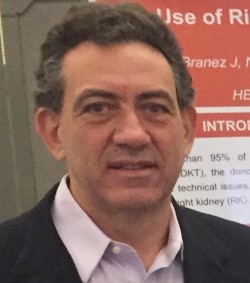
Director of Pancreas and Kidney Transplant Program, Leforte Hospital, Sao Paulo, Brazil
Largest Experience in pancreas transplantation of Latin America with over 1,000 pancreas transplants performed.
Our pancreas transplant program has been one of the most active of the world for the last four years performing from 50-90 PT annualy.
Ipsilateral versus contralateral simultaneous pancreas and kidney transplantation: A single-center analysis of 141 cases
Marcelo Perosa1, Bruno B. Lubraico1, Juan Branez1, Fernanda Danziere1, Leonardo T. Mota1, Aline Rocha1, Adriana B. Bortoluzzo2, Maria K. Venezuela2, Leon Alvim1.
1Department of Abdominal Organ Transplantation, Leforte Hospital, São Paulo, Brazil; 2Statistics and Data Science, INSPER Institute of Education and Research, São Paulo, Brazil
Ipsilateral simultaneous pancreas-kidney transplantation(iSPK) is an attractive surgical strategy searching to reduce operative time and preserve the left iliac fossa for an eventual future transplant. There have been few reports describing iSPK.The goal of this study was to compare iSPK to the traditional contralateral SPK(cSPK).
A retrospective analysis was performed of 40 iSPK and 101 cSPK from 2018 to 2021. The decision for graft placement was made during the procedure and based on physical characteristics of recipient(dimension of pelvis) and donor pancreas and kidney. Donor and recipient data, surgical and cold ischemia time(CIT), delta time between kidney and pancreas CIT , surgical complications, reoperations and patient and graft survival were compared between the 2 groups.
Donor and recipient demographics were comparable. Cerebrovascular event as cause of donor death (35% x 26.7%, p=0.44) and rate of preemptive SPK(2.5% x 2.9%) were also similar between iSPK and cSPK group, respectively. The operative time was similar(312 x 325min, p=0.109) while pancreas CIT was higher(8.5 x 7.9 hours,p=0.0049) and kidney CIT was lower (8.9 x 9.8 hours,p<0.001) for iSPK. Delta time between kidney and pancreas CIT was inferior in iSPK(23.3 x 120.8 min, p<0.001) and became even more evident when simultaneous pancreas and kidney reperfusion iSPK was employed(5.5 x 120.8 min, p<0.001). The rate of kidney DGF (47.5% x 42.5%,p=0.73) and hospital stay(7.7 x 7.9 days,p=0.99) were similar between the 2 groups.There was a tendency of higher 1-year patient (87.5% x 79.2%,p=0.33), pancreas(85% x 71.2%,p=0.13) and kidney(82.5% x 78.2%,p=0.73) survival among iSPK although not statistically significant. Pancreas technical failure tended to be lower(2.5% x 10.9%, p=0.71) in iSPK while need of blood transfusion(15% x 17.8%, p=0.87) and rate of reoperations( 15% x 19%, p=0.77) were similar between the groups.
There were no significant differences in overall outcomes. iSPK is a safe procedure with a slightly higher pancreas and lower kidney CIT and may save up to 2 hours of kidney ischemia time compared to cSPK. iSPK tended to achieve superior patient and graft survivals and lower technical pancreas graft failure, however a larger series is required to further conclusions.